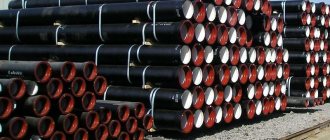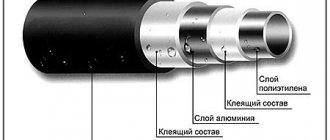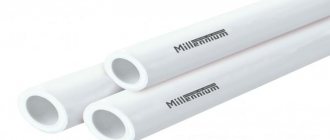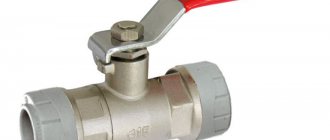Water is supplied to an individual house from any water supply source through an underground pipeline, the probability of freezing in winter is quite high. It is not always effective and technically possible to immerse a water pipeline to a great depth underground; many owners of land plots with an autonomous water supply have to solve the problem of how to insulate a water pipe in the ground.
To supply water to the house, no one uses underground metal pipes, which are prohibited for laying underground without waterproofing by building regulations; the leader in household use is a pipeline made of low-density polyethylene (HDPE) with a diameter of 1 to 2 inches. Although polyethylene has a low thermal conductivity, unlike steel, and is more resistant to freezing due to its elasticity, when laid at shallow depths it should be insulated using one of the many methods used in the construction industry.
Soil freezing depth in the Moscow region (in centimeters)
Why is insulation necessary?
There are several reasons why underground water supply should be insulated, all of them are related to the rules for laying communications and financial savings - this is obtained after the insulation work has been carried out. The main reasons for thermal protection of water pipes:
- When laying an underground water supply line, the possibility of draining water from the system is taken into account; for this, the pipeline is laid with a slope of about 20 mm per linear meter towards the source. If the house or cottage is located at a great distance from the well or well from which water is drawn, for example, 50 m, then when laying a pipeline near the house at an average freezing depth of about 1.5 m at the entrance to the source, you will have to bury the pipe at 2.5 m (0.02 x 50 = 1 m). This is not economically feasible and quite difficult to implement technically.
- To collect water from wells, caisson wells are often used, into which pumping equipment is placed and the electric pump is maintained. A standard caisson tank has a depth of immersion underground of about 2 m, while the upper pipe of the casing, according to standards, is located 50 cm above the floor level. Thus, at the exit from the caisson chamber, which is an unheated room, the pipeline is placed at the lower mark of the freezing depth of 1 .5 m, and given that when connecting to the house through the basement a slope is required, the entire section of the water supply will be above the freezing point - accordingly it must be insulated. Read more about plastic caissons.
Thermal conductivity of insulation - Insulating water supply pipes in a private house that run underground allows you to save significant funds that are spent on heating cold water for household needs. It is clear that less cooled water after flowing through an insulated water supply system will require less electricity for heating than cooled water after passing through a non-insulated pipeline.
- It is known that thermal insulation of an underground water supply system from contact with the ground does not heat the pipes, but prevents heat loss, so insulated water supply pipes can also be used effectively in the summer - they prevent the heating of water when the main line is shallow.
- To prevent freezing, they not only insulate water pipes in the ground, but also on its surface at the exit from the well and the entrance to the house, if it is located on stilts; for this, thermal insulation methods and materials similar to underground communications are often used.
Self-regulating electrical cable device
Methods for insulating external water supply
There are many ways to insulate a street water supply system located in the ground. If only cold water is supplied, then due to the small temperature difference, the thermal conductivity of the materials used is not as important as their durability, strength or price.
For hot water supply supplied to a country house by a centralized network, ground routes are insulated. Due to the large temperature difference between hot water and the environment, great attention is paid to the thermal conductivity of the material
Application of simple techniques
If the pipes are located almost on the border of the freezing zone, then to eliminate the possibility of stopping the water supply, you can perform simple actions that do not require large investments and qualified work.
For the southern regions, where the water supply is shallow, it is enough to dig up the pipes in the fall, cover them with environmentally friendly insulating material and bury the trench again.
For insulation, you can use leaves, straw, shavings or sawdust. They have low thermal conductivity, but by next winter they will have time to rot in the ground, so this procedure must be repeated annually.
If, according to calculations, the pipes are located slightly above the level that ensures that the system does not freeze, then instead of deepening the water supply, you can solve the problem by raising the zero isotherm.
This can be done in two ways:
- increase the thickness of the soil layer by pouring it on top;
- use fallen snow for insulation.
In both cases, the center of the strip of earth or snow is located along the water pipeline, and its width should be at least twice the depth of the pipes.
Snow is a good natural insulator. Even a 30-centimeter layer of it can halve the depth of freezing of the ground
The filling of earth will change the landscape of the local area, and insulation with the help of plant and wood waste or snow must be carried out constantly. Therefore, for a long-term and reliable solution to the problem of water pipe insulation, specially developed materials are used.
A water pipeline laid below the level of seasonal soil freezing in the region is insulated only in the area passing through the thickness of rocks that freeze in winter. Thermal insulation is installed from the specified level before the pipe enters the house.
If the water supply is brought into the house through an unheated basement, located below the freezing depth, then insulation is carried out within the basement. Then a wooden box is placed around the water supply section, and the space between it and the pipe is filled with sawdust or basalt wool.
Types and forms of materials
To insulate water pipes, materials are used that are presented in the form of shells - shapes that follow the contours of pipes and system components. They are made from basalt wool, glass wool, polystyrene foam, extruded polystyrene foam, polyurethane foam, foam glass.
In the case of using mineral wool and glass wool, a prerequisite for underground installation is the presence of a foil sheath. It prevents the insulation from getting wet, which practically destroys the insulating properties of the material. The shell can be replaced by winding a pipe with basalt insulation with roofing felt.
Due to the ability to easily absorb moisture, cotton wool insulation in the form of mats cut into slabs or rolled into bales without waterproofing external protection is not used in the construction of underground networks.
An exception may be when laying the pipeline in concrete trays and filling the free space between the tray and the pipe with expanded clay or similar material.
The presence of a structural seam in cylindrical insulation based on glass wool makes it easy to install the product on a water supply system
Thermal insulating shells are ready-made cylindrical blanks, whose internal diameter coincides with the external diameter of the pipes. Products ranging from 60 cm to 2 meters in length consist of a single tube with a construction seam, if the insulation material is elastic, or of several (usually two) sections. The main advantage of sectional insulation material is the ease of installation of the product.
The connection of the halves of a relatively thin shell occurs with the edge of the element overlapping the next element to avoid the formation of unprotected sections of the pipeline. The displacement of meter segments is usually 15-20 cm.
If you need to use thicker insulation, it is better to choose a shell with a mounting chamfer along the end edge. The second option for ensuring tight connections is to slightly shift the parts of the shell relative to each other.
To form strong shell connections and increase the rigidity of the heat-insulating structure, it is recommended to slightly shift the shell parts relative to each other
When attaching parts of the shell, use plumbing tape. The junction of pipe bends, bends and other system components is protected using special shaped forms.
Thermal insulation paint and polyurethane foam spraying
One of the additional solutions to prevent freezing of the external water supply line located in the ground is liquid or sprayed thermal insulation. This method allows you to reliably, without seams or cold bridges, protect areas with complex geometry, for which it is difficult to use standard materials for insulation.
Polyurethane foam has a liquid consistency and is applied to insulated objects by spraying. Possessing one of the best thermal conductivity indicators, as well as a number of other positive properties, this material has a significant disadvantage: special equipment is required for its application.
Polyurethane foam is one of the best insulation materials for underground water supply. However, its spraying is a technologically complex process that requires expensive equipment, compliance with safety regulations and professional skills.
It is not difficult to find companies that deal with insulation using polyurethane foam, since it is actively used at various facilities. However, all service providers have restrictions on the minimum spray area, so it is unlikely that it will be possible to find an affordable option solely for the sake of 10 or 20 meters of pipeline.
Special heat-insulating paint for pipe insulation, similar to polyurethane foam, can be applied by spraying. It is sold in cans, so this procedure is easy to do yourself. There is also an option in liquid form, which allows you to paint the plumbing elements using an ordinary paint brush.
Image gallery
Photo from
Composition of liquid ceramic thermal insulation
Applying the composition with a spray gun
Painting rusty pipes
Pipes in an unheated basement
Thermal insulating paint contains additives in the form of ceramic microspheres, foam glass or perlite. The thermal conductivity of this material is quite low, however, due to the thin layer of application, it alone may not be enough to solve the problem of insulating a section of a water pipeline crossing the thickness of freezing soils.
Due to the high cost, applying a thick layer of insulating paint is expensive. Therefore, its use for insulation is justified only in areas with complex geometry or in places where cold bridges may occur.
The use of heat-insulating paint is justified both for external and for areas of water supply systems with complex geometry located in an unheated basement or in the ground
However, in the case of using steel pipes, using paint along the entire length together with other insulation may be advisable for another reason. The presence of porous material in the composition leads to a high adhesion rate, eliminating the possibility of external corrosion, which is important for metal structures located in the ground.
Ready-made integrated solutions
The problem of freezing of a street water supply branch is very relevant. Demand creates supply and, therefore, there are a large number of ready-made integrated solutions on the market in the form of thermally insulated pipes and connecting elements. They are pipelines surrounded by insulation, which is enclosed in a hard or flexible shell.
Image gallery
Photo from
Pre-insulated pipes for communications
Installation of pipelines of any complexity
Units and connections in pipeline systems
Scope of use of pre-insulated pipes
There are both single-pipe and double-pipe options for a ready-made solution for insulating external pipe installations. For regular cold water supply, the best option is structures containing plastic pipes. They are cheaper than their metal counterpart and are characterized by high installation speed.
Insulated HDPE pipes are supplied in coils up to 200 meters long. The installation of water supply systems based on them can be done with a minimum number of joints.
If corrugated material is used as the outer shell, it is possible to lay the pipeline without the use of corner joints. This is possible due to the ease of making small radius bends of all parts of the kit.
There are ready-made complex solutions for insulating water supply systems. Available with one or two pipes of different diameters
Methods for insulating underground water pipelines
There are several ways to insulate water mains, many are used in everyday life or only in the national economy, the main ones are:
- Application of thermal insulation materials . Insulation materials used to isolate water pipes from contact with the ground are widely used in all sectors of the national economy and in everyday life; they occupy a leading position in terms of efficiency and material costs.
- Electric heating . An electric cable, the sheath of which heats up when alternating current passes, is a popular means of combating pipe freezing in industrial and domestic environments. Modern self-heating cables operate automatically with minimal energy consumption thanks to an internal device that increases energy consumption when the ambient temperature drops. Electric cables are moisture-resistant and can work in water, so they are often laid inside water pipes, and the combination of electric heating with external thermal insulation is the most effective method of combating pipe freezing.
Options for laying electric heating cables
- Continuous flow. Moving water does not freeze, so a small regular use of water or circulation in a closed loop can prevent the pipeline from freezing in winter.
- Air heating. The technology is used in public utilities and the industrial sector; to implement it, underground water supply is placed in a shell of large-diameter pipes, and heated air masses are pumped into the space between the shells.
Note: In domestic conditions, an analogue of this method is sometimes used without pumping warm air; for this, HDPE water supply is placed in a polypropylene PP or polyvinyl chloride PVC pipeline of larger diameter from sewer pipes - the air gap between the pipe surfaces is an excellent thermal insulator.
- Increased pressure. One of the popular Internet myths is the claim that you can lower the freezing point of water by increasing the pressure in the system. It can actually be lowered by 1 °C when a water flow is pumped into a pipeline with a pressure of 132 atm, which is incredible for a household water supply with a maximum pressure threshold of about 5 atm.
Comparison of the best insulation materials
Requirements for insulation materials
To insulate a water pipe in the ground located at a shallow depth, construction insulation materials are most often used, which must meet the following criteria:
- Low thermal conductivity . This is the main condition; the more the material prevents heat transfer between the pipe shell and the soil, the more effective its use and, accordingly, the financial savings.
- High chemical resistance. The soil contains a large amount of minerals, which have a negative effect on the structure of the material placed in the ground, so the insulation should not be subject to rapid decomposition when placed in the ground.
- Water resistance. There is always moisture in the soil, so the material should not allow water to pass through or absorb it into its shell - this sharply reduces its thermal insulation properties.
- Temperature resistance. Thermal insulation material when located underground must withstand low ambient temperatures in the cold season and high temperatures in the summer, as well as their significant differences.
Examples of thermal insulation of pipes in a coffered pit
- Biostability. The earth contains a large amount of organic matter from microbes, bacteria, mold, the material should not be destroyed under their influence, and it should not be absorbed by underground living organisms.
- Rigidity. The material lowered under the soil layer experiences significant loads from the top layer of soil, so increased demands are placed on it in terms of strength and rigidity. Because of these qualities, a large number of construction pipe insulation materials are not suitable for underground installation.
- Long service life. It is advisable that the material lowered into the ground should be changed as rarely as possible - this will save financial resources and save personal time.
Instructions for installing a heating cable for underground pipe installation
When installing a single-core wire, it should be taken into account that in order to be able to connect it, it must go through the pipeline and then return back. This way you will have two ends that can be connected to a power source.
Work should be carried out in the following sequence:
- lay the cable along the pipe from beginning to end, temporarily securing it with tape;
- move the cable to the opposite side of the pipeline and pull it in the opposite direction;
- stick foil tape over both threads, which will ensure complete fixation of the wire and reflection of the heat flow towards the pipe;
- install the selected insulation throughout the water supply;
Spiral laying of heating cable.
- wrap the surface with waterproofing plumber's tape or waterproof the surface in another reliable way.
Before laying the pipe in the ground, it is necessary to test the installed heating system. To do this, connect the cable to the power source and make sure that heating occurs at the visible end sections.
Thermal insulation materials for underground water supply and their features
In the construction industry, a variety of insulation materials are used, which are produced in rolls or sheets; it is clear that shells shaped like their surface are better suited for insulating pipes. Almost all materials used for thermal insulation are produced in the form of pipe shells, some of them have built-in channels for laying electric heating cables.
Foam pipe casing
Styrofoam
Expanded polystyrene EPS (foam plastic), due to its physical parameters and rigidity, is the most suitable option for thermal insulation of underground pipelines; its distinctive qualities are:
- One of the lowest thermal conductivity coefficients with an average value of about 0.04 W/m °C.
- High rigidity (depending on the brand) makes the material indispensable when used in environments with high loads on the shell; its density reaches 50 kg/m3.
- Polystyrene foam does not transmit or absorb water; water absorption depends on the density of the material and on average does not exceed 2%.
- Low cost, thanks to which polystyrene foam is available to a wide range of consumers.
- The service life of a foam shell underground is up to 40 years.
- The temperature range for using polystyrene foam is from -50 to +70 °C.
- Expanded polystyrene is resistant to chemical and biological effects of the underground environment, does not decompose under the influence of mold, bacteria, microbes and other microorganisms.
- The foam shell is lightweight and can be easily installed by one person in a short time without additional assistance.
An analogue of expanded polystyrene is the extruded variety (Orange Penoplex), which has higher strength characteristics, density, low water absorption of about 0.2% and thermal conductivity of about 0.3 W/m °C. Shells for thermal insulation of pipelines are also made from extruded polystyrene foam; it costs a little more than regular polystyrene foam.
Pipe polyurethane foam
Polyurethane foam
PPU polyurethane foam is the leader among all insulation materials in terms of thermal conductivity; thanks to this quality, it is widely used in the industrial production of insulated pipes with a zinc or polymer outer shell. The construction market offers polyurethane foam shells of various diameters and their characteristic features:
- Higher price compared to foam.
- Thermal conductivity coefficient is 0.025 W/m°C.
- Temperature range of use from -160 to +150 °C.
- Polyurethane foam has high rigidity and strength, its density reaches 250 kg/m3.
- The material is resistant to chemical and biological influences, does not allow water to pass through, its water absorption is 1 - 2%.
Polyethylene foam
Shells and foamed polyethylene PPE (Penoplex, Energoflex) are widely used for thermal insulation of external pipelines in individual houses; they can be used outdoors to seal open sections of pipes located in a caisson well or entering a house on stilts.
Polyethylene foam tubes
Due to their low rigidity, polyethylene foam tubes crumple when used underground without a hard shell and, due to a decrease in thickness, significantly lose their heat-insulating qualities, the main parameters of polyethylene foam:
- Thermal conductivity 0.31 - 0.55 W/m °C (depending on the brand, the figure is lower for products made using cross-linking technology).
- Temperature range -60 - +75 °C.
- Density from 25 to 100 kg/m3.
- Polyethylene foam does not allow moisture to pass through or absorb moisture, its water absorption coefficient does not exceed 1%.
Mineral wool
Insulation materials made from glass and basalt wool are widely popular among consumers due to their affordability and environmental friendliness, allowing their use inside residential premises. Glass wool has low rigidity and easily wrinkles, basalt-based material is stiffer, but due to the main disadvantage - high moisture absorption, shells made of quartz and basalt are not laid underground. Like other soft materials, mineral wool is used to insulate external water supply in coffered wells and supply points to the house.
Mineral wool shells
Mineral wool has the following characteristics:
- Thermal conductivity coefficient is 0.033 - 0.05 W/m °C.
- Water absorption is about 10%.
- Temperature range from -60 to +450 °C for glass wool and -100 - +700 °C for basalt (depending on manufacturing technology).
- Density 30 - 225 kg/m3.
- Mineral wool is resistant to most chemicals, non-flammable and does not support combustion.
- The cost of mineral wool is 2 times higher than that of expanded polystyrene.
Thermal insulation paints
This type of heat insulator is classified as a high-tech product; the acrylic-based paint contains perlite, foam glass particles, quartz fibers and microscopic granules containing a vacuum inside the shell. Thermal paint is applied to the surface to be treated with a brush or spray in several layers up to 4 mm thick; it is mainly used for treating surface pipelines and containers in the national economy; in everyday life, the use of this product is not economically feasible due to its high cost.
Application of heat-insulating paints
In addition, many experts are not confident in the veracity of the information provided by the manufacturer about the thermal conductivity of paint below that of air (0.0012 W/m °K versus 0.022 - 0.025 W/m °K), and indicate other data in independent calculations - 0. 07 W/(m·°K.) - this is lower than the values of any of the standard heat insulators.
Sprayed heat insulators
In industry, liquid polyurethane or polystyrene is often sprayed onto insulated surfaces, the two components are mixed and the composition is applied to the pipe shell with a spray gun. After spraying, the substance increases in volume and provides reliable thermal insulation of the object without cold bridges with high tightness.
Due to its high cost, the technology is rarely used in everyday life by individual homeowners, but theoretically, this installation can be used to coat HDPE pipes if you agree on a price with its owners.
Spraying polyurethane foam
How to insulate water supply pipes yourself
Before insulating a water pipe in the ground, they choose a suitable option, taking into account the financial costs of purchasing materials and carrying out work; they often choose to use cheap high-density foam plastic shells. Some homeowners use a shell of sewer pipes with a cross-section of 110 mm, placing a HDPE pipeline in them - air is the best heat insulator.
Recently, the method of heating the outer or inner shell of pipes with a self-regulating electric heating cable has become popular; ready-made systems with fittings for inserting electric cables into the pipeline are being sold in the retail network. Thus, the highest efficiency of heating the water supply system is achieved.
Insulation of PPS shell
Due to its low price, availability and suitable physical characteristics, a foam shell is the best option for solving the problem of insulating an underground water supply pipe on the street. Do-it-yourself installation of a shell on a HDPE pipeline does not present any particular difficulties for any owner and is carried out in the following sequence:
- A foam shell is put on the pipeline lifted from the trench, snapping the locks and moving each segment approximately 1/3 in relation to the opposite element. The elements are fixed to the surface with tape or plastic ties.
- After fixing the PPS segments, the pipeline is lowered into a trench onto a pre-prepared sand cushion with a thickness of 150 - 200 mm - this will prevent distortion of the thermal insulation shell with possible fracture.
- Then the trench is filled with soil raised to the surface, and the removed turf is laid out.
Installation of PPS shell
Insulation of water supply system with self-regulating electrical cable
Insulating an underground water supply by heating the pipe with an electric cable is one of the effective methods of combating freezing when the water supply line is shallow. The heating cable can be used along the entire length of the pipeline or in a separate section, it can also be immersed inside the pipe shell or left outside on the surface of the pipe. On the construction market, they sell electrical cables with fittings for insertion into the pipeline, equipped with sealing rubber glands; the wire itself is short in length and is usually placed at the outlet of the pressure pipe from the well. In this place, the efficiency of its use is highest - heated water will flow along the entire pipeline from the well to the house, preventing pipes from freezing. In addition, laying the cable at the junction of the pressure pipeline from the electric pump with the water supply line is technically easier to implement than in any other more inaccessible place, which is usually not found along the entire water supply line.
Kit with self-regulating cable for installation in pipelines
Insulation of a pipe, when the water supply is in the ground, and it needs to be heated from the outside with an electric cable, is carried out as follows:
- Place the HDPE pipeline on the surface of the earth next to the trench, clean the area where the electrical cable is laid from dirt.
- Wrap the pipe surface at the point of contact with the electrical cable with aluminum foil tape - this increases the thermal conductivity of the shell at the point of contact. If the wire is placed in a straight line along the length of the pipe, one or more straight strips of foil tape are glued; if the cable is placed in a spiral, the entire pipe is wrapped with tape.
- After laying the heating wire, screw it with the same foil tape to the surface of the pipe along its entire length.
- To reduce heat losses, be sure to use an outer shell made of PPS foam, polyurethane polyurethane foam, which is placed on top of the heating wire and secured with tape or plastic ties.
Tip: If the wire is running in a straight line, it is better to purchase a shell with a groove cut into the inner shell to accommodate the electrical cable.
- After installing the heating section, screw the power supply cable along the entire length to the pipeline with electrical tape or tape and lower the assembled structure into the trench, after which it is covered with earth.
Installation of heating electric cable on a pipe
To insulate water pipes for individual water supply, inexpensive foam shells and self-heating electric cables are most often used, and often both methods are combined. Carrying out installation work on placing a heat-insulating shell and a heating wire does not cause any particular difficulties and does not require high qualifications; with knowledge of the technology, all actions can be performed in a short time without much labor input by one person.
Insulation for seasonal and permanent residence
Of course, in each specific case different insulation will be used. For example, in a country house where water is needed only once a season, experts advise insulating pipes with glass wool. But for temporary housing, automatic or semi-automatic heating systems are still more suitable: heating cable, pressure. When you return, you can always heat the water by heating, and in the second case, by first turning on the pump.
So, to insulate your home water supply you need:
- choose good material;
- choose the appropriate insulation method depending on the frequency of use of the water supply (seasonal or permanent);
- carry out the work carefully, with special attention to detail, strictly following the instructions and advice of the masters.
Insulating water pipes in the ground is a task that requires attention to detail, meticulous selection of materials and methods, but it is quite feasible for every home craftsman (no matter what method you choose).











